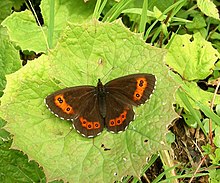Erebia
| Erebia | |
|---|---|
 |
|
| Arran brown (type species) | |
| Scientific classification | |
| Kingdom: | Animalia |
| Phylum: | Arthropoda |
| Class: | Insecta |
| Order: | Lepidoptera |
| Family: | Nymphalidae |
| Subfamily: | Satyrinae |
| Tribe: | Satyrini |
| Subtribe: | Erebiina |
| Genus: |
Erebia Dalman, 1816 |
| Type species | |
|
Papilio ligea Linnaeus, 1758 |
|
| Diversity | |
| Around 100 species | |
| Synonyms | |
|
Atercoloratus Bang-Haas, 1938 |
|
Atercoloratus Bang-Haas, 1938
Epigea Hübner, [1819]
Gorgo Hübner, [1819]
Marica Hübner, [1819]
Medusia Verity, 1953
Phorcis Hübner, [1819]
Simplicia Verity, 1953 (non Guenée, 1854: preoccupied)
Syngea Hübner, [1819]
Triariia Verity, 1953
Truncaefalcia Verity, 1953
Erebia is a Holarctic genus of brush-footed butterflies, family Nymphalidae. Most of the about 90–100 species (see also below) are dark brown or black in color, with reddish brown to orange or more rarely yellowish wing blotches or bands. These usually bear black spots within, which sometimes have white center spots.
This genus has found it easy to adapt to arid and especially cold conditions. Most of its members are associated with high-altitude lands, forest clearings or high latitude and tundra. Erebia species are frequent in the Alps, Rocky Mountains, subarctic and even arctic regions, and the cooler parts of Central Asia. In fact, the North American term for these butterflies is "alpines". Eurasian species are collectively known as "ringlets" or "arguses". However, none of these terms is used exclusively for this genus.
The genus Erebia was erected by Johan Wilhelm Dalman in 1816. As type species, the Arran brown—described as Papilio ligea by Linnaeus in 1758—was chosen. This is a very complex genus with over 1300 taxa, but a massive proportion of these are junior synonyms. Some of the available names are listed by Vladimir Lukhtanov. A fully comprehensive taxonomic checklist (i.e., without discussing synonymy and relationships) was published in 2008.
...
Wikipedia
